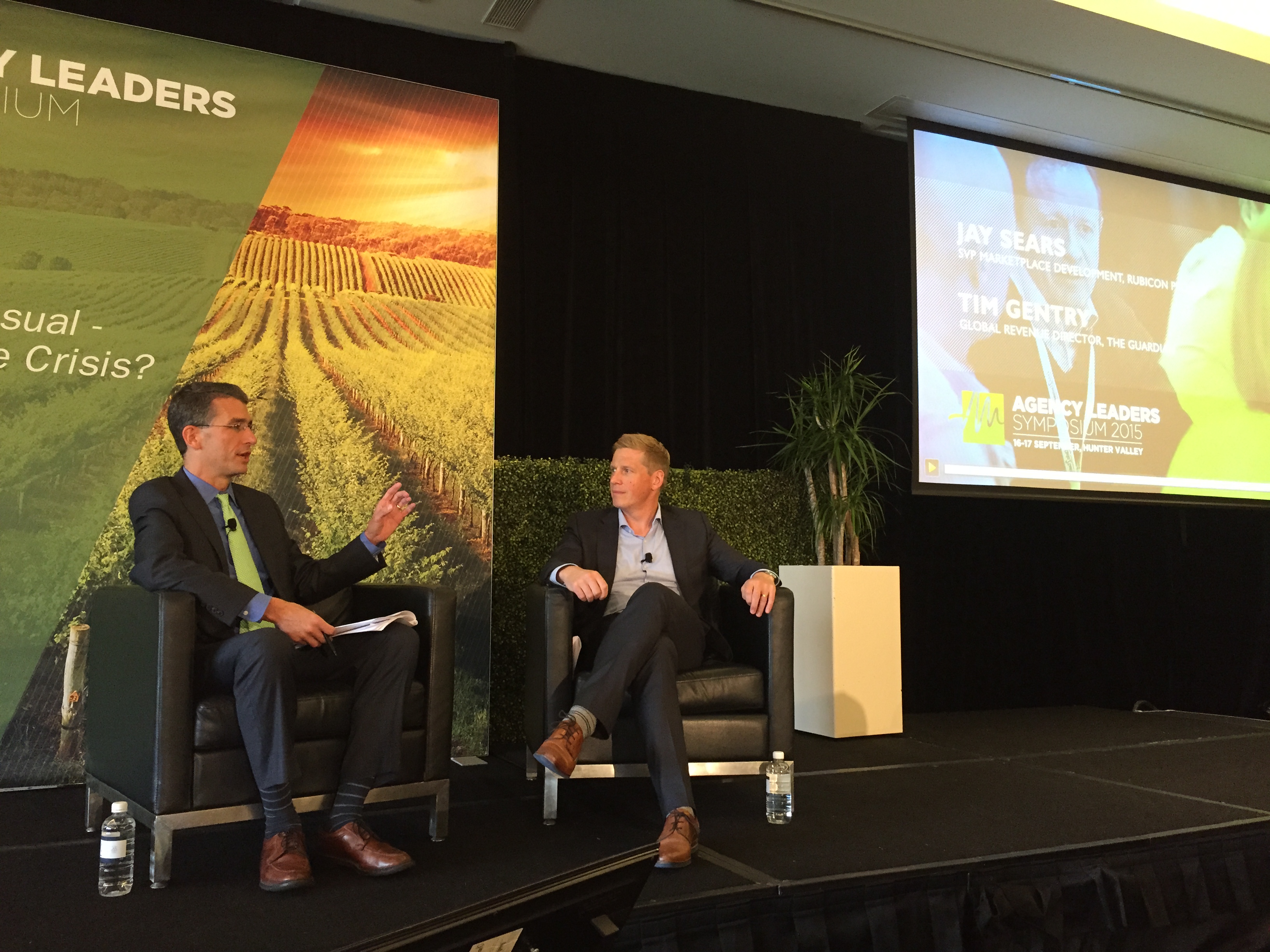Guardian and the Pangaea Alliance: Quality Programmatic at Global Scale

CNN International, The Economist, Financial Times, The Guardian and Reuters -- a group of select business brands with a massive global audience -- have recently joined forces to create the Pangaea Alliance on the Rubicon Project advertising automation cloud. Jay Sears, Senior Vice President Marketplace Development at Rubicon Project recently discussed advertising automation and the rationale for Pangaea with Tim Gentry of Guardian News & Media.
(Photo above: Jay Sears of Rubicon Project, left, and Tim Gentry of Guardian News & Media at the Agency Leaders Symposium in Hunter Valley, Australia during the fall of 2015.)
YOUR NAME: Tim Gentry
YOUR COMPANY: Guardian News & Media
YOUR TITLE: Global Revenue Director
SEARS: What do you read to keep up with politics, art and culture?
GENTRY:The Guardian, The Economist, New York Times
SEARS: What do you read to keep up with friends?
GENTRY:Facebook, Strava
SEARS: What do you read to keep up with our industry?
GENTRY: AdAge, Ad Week, Campaign, ExchangeWire, etc. as curated by Twitter
SEARS: What's your favorite commercial of all time?
GENTRY: Honda -- The Cog
SEARS: With regards to advertising automation and programmatic, what are the Guardian's three biggest company-wide initiatives for 2016?
GENTRY:
1. Beyond Viewability. We launched a viewability optimized responsive site last quarter. We've seen very big lifts in overall viewability; this coming quarter we will look at how we package and present our inventory -- directly and automated -- to help advertisers unlock the new value that is being created. We've also just launched Guardian Response+ Assured in the UK -- a new premium programmatic product, which guarantees that 100% advertisers' spend will be viewed by real people.
2. Data. We've always been leaders in our use of data from our first behavioral partnerships with Audience Science in 2005 to the launch of GR+ in 2013, but the Guardian generates so much interesting data that the work is ongoing. The next phase is all about joining up some of the new data sets that are being created, with a focus on our unique in house insights and improving visibility of these data sets across the inventory stack.
3. People. The team and expertise continues to grow; we've now got experts in Australia and the US, as well as in London working on the Guardian and Pangaea -- commercial leaders, sales people and analysts with product expertise with backgrounds from publishing to big five tech and trading desks. Helping them be at their best continues to be our most important initiative from which everything else flows
SEARS: What was the rationale for the Guardian joining the Pangaea cooperative? What is the opportunity?
GENTRY: We were looking at some fundamental trends across the industry -- the globalization and growth of news, the increasing demand for content and the growing audiences for a range of news brands like Guardian and The New York Times, as well as for Buzzfeed and Vice. We also looked at the continued growth of programmatic -- 47% of UK spend last year -- as well as the increasing importance of first party data and the consolidating environment on the supply side. We looked at all these factors and thought long and hard about what this meant for the industry and what was missing.
The Guardian led the formation of Pangaea because we firmly believe in the value proposition of quality audiences in trusted environments, which can be delivered at scale. We believe this is a huge step forwards in solving increasing advertiser concerns about trust and transparency of programmatic solutions. Pangaea offers advertisers a targeted audience solution that draws from cross-publisher behavioral insights. Put simply, this enables us to combine the individual strengths of the alliance publishers to create unique segments that are delivered back across the Publisher sites.
SEARS: What is the current state or the near term plan to integrate Pangaea into the Guardian's sales and operations?
GENTRY:It has taken an education effort, but we shouldn't be surprised as we are working in brand new territory! Pangaea's small team is well integrated into the Guardian's current operations and is comprised of seconds from the existing business, led by new hires Fiona McKinnon and Cadi Jones. Fiona joined us with a wealth of international digital and business experience and Cadi joined us from Yahoo! having most recently led programmatic efforts across Northern Europe. The Guardian sales team also plays a key role in evangelizing the product to existing agencies and advertisers.
SEARS: Media owner first party data is a key leverage point for the best known media brands. How do you leverage your first party independently and how is media owner first party data leveraged with Pangaea?
GENTRY:Independently, Pangaea publishers offer a wide range of solutions based on their individual first party data. The Pangaea audiences are comprised behavioral data from the founding members and have far greater scale than each individual publisher could achieve on its own. These data segments are comprised of cross-publisher content consumption and allow advertisers to find users across all sites.
Pangaea currently has targeted segments combined within key contextual channels in four regions (UK, USA, APAC and Global). An example of these combined audiences would be Business Travellers and Personal Finance.
The Guardian itself has three core products:
- Guardian Response+ -- leveraging audience data at a log level to optimize to campaign KPIs
- Audiences not Platforms -- using 80+ audience segments to plan branding campaigns across the Guardian's cross platform audience
- Guardian Labs -- which uses audience data to inform our approach to telling brand stories.
We also have a range of PMPs available via platforms such as Rubicon Orders.
SEARS: Ad automation/programmatic has been used smartly as the "tip of the spear" for entry into global markets. Have you pursued this strategy independently? And does Pangaea contribute to this strategy?
GENTRY:In both the US and Australia our business as we started was largely automated, but as we've invested in those markets and seen the appetite that exists both for the Guardian's unique style of journalism and opportunities for advertisers to engage with our growing audiences the teams and the complexity of commercial offerings have grown. Here in Australia for example, our fastest growing work is in helping advertisers tell brand stories with Guardian Labs.
With Pangaea, we now have the scale to feature in more markets in the way that we found ourselves unable to alone in the US and Australia and to be relevant to a wider range of buyers for both local and pan-regional budgets. So long as we see our early signs of encouragement play out, this then gives us the platform to make better informed decisions about our investment in journalism and audience growth in other markets.
SEARS: Tell us the about the global advertising operations of the Guardian.
GENTRY:We've seen our 194-year-old business transform over the last few years from the 9th largest newspaper in the UK to become one of the world's top sources of quality news. We are still working hard to grow our operations and commercial footprint at the pace of the changing behavior of our audiences. Today we have revenues of around $330m, over half of which is digital, and commercial teams centred in UK, the US and Australia. In US and Australia audiences, revenues and teams are growing very quickly; we're in start-up mode, whilst in the UK we have a mature business where the growth is more stable but the energy required to transform ahead of the pace of our audiences and the market is remarkable.
SEARS: Tell us your view -- draw an analogy between the automation of television and a European football game. Are we in the pre-game? Still driving to the stadium?
GENTRY:In my view we are in the pre-game. Some significant moves have been made to make TV more addressable, eg by Sky. YouTube viewing on TV is increasing rapidly, but the big money remains in linear.
SEARS: Can linear TV be automated, yes or no?
GENTRY:I'm sure it can be technically. We've found a way with most other media so the barriers are surely around economics and change management. The question is, does it make good sense to invest the time in leading the change and are we willing to?
SEARS: What two-three events or happenings will accelerate the automation of television?
GENTRY:1) The growth of audience time spent with addressable video. 2. Once audience growth has happened, marketer recognition of improved value in addressable media relative to linear. For example in the UK, because of the TV trading model, in linear TV you get significantly less for the same investment today as you did a year ago. But the power of the medium in reaching large audiences in one go and proven ROI models means it still makes sense.
SEARS: Which of the following will accelerate the automation of site direct (direct orders) budget? Pick all that apply:
A) Dynamic access to all publisher inventory [vs. just "remnant" or "auction"]
B) Ability to leverage publisher first party data
C) Ability to leverage advertiser first party data
D) Availability of rich media, expandable units and larger IAB Rising Star formats
E) Ability to more easily curate audiences for specific advertisers across the premium content of multiple publishers
GENTRY:A, C, D and E. Not B, because this is already available in a biddable environment.
SEARS: Tell us a bit more about you.
GENTRY:Weekends for me consist of juggling time between my wife, my sons aged 12 and 17, my bikes, friends and church. I'd happily devote the whole weekend to any one of them.
SEARS: If you could go to the airport right now with friends or family and fly anywhere in the world for vacation, who would you take and where would you go?
GENTRY:Right now (as I write this) I would grab my immediate family and one family of friends and fly to Portland, Jamaica, eat amazingly, and pass the time with dominoes, reading and swimming.
SEARS: If you could create an endowment to fund any existing non-profit you designated, what lucky non-profit organization would that be?
GENTRY:It would have to be Oxfam, an international confederation of 17 organizations working in approximately 94 countries worldwide to find solutions to poverty and what it considers injustice around the world.
SEARS: What is your favorite restaurant in the world?
GENTRY:Istrenn Passion, a great place in Trinite Sur Mer, Brittany, France. It's an oyster shed, right by the sea, run by two of the coolest Frenchmen you could ever meet who do it all -- get the food out of the sea, prepare it and serve it. The menu is fruit de mer, frites and two choices of wine, sancerre or sancerre.
SEARS: Thanks, Tim!
The opinions and points of view expressed in this commentary are exclusively the views of the author and do not necessarily represent the views of MediaVillage.com/MyersBizNet, Inc. management or associated bloggers.


